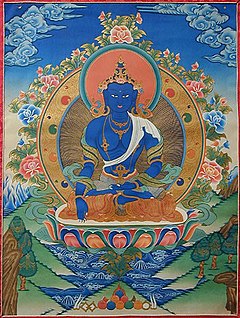Akṣobhya
Akṣobhya (T. mi bskyod pa མི་བསྐྱོད་པ་; C. achu fo 阿閦佛) is a buddha recognized in the Sanskrit Mahayana tradition. His name means "immovable," "unbreakable," "imperturbable," etc. He is said to be immovable in his vow to proceed to Buddhahood, particulary through mastering the practice of ethical conduct (sila).[1]
He presides over buddha field of Abhirati.[1]
In the Vajrayana, Akṣobhya is identified as one of the five tathagatas.
In the early Mahayana period
The Princeton Dictionary states:
- The cult of Akṣobhya may have been the first to emerge after the cult of Śākyamuni, and before that of Amitābha. In the Saddharmapuṇḍarīkasūtra, Akṣobhya is listed as the first son of the buddha Mahābhijñā Jñānābhibhu, and his bodhisattva name is given as Jñānākara. His cult entered China during the Han dynasty, and an early text on his worship, the Akṣobhyatathāgatasyavyūha, was translated into Chinese during the second half of the second century. Although his cult was subsequently introduced into Japan, he never became as popular in East Asia as the buddhas Amitābha or Vairocana, and images of Akṣobhya are largely confined to maṇḍalas and other depictions of the pañcatathāgata.[1]
Within the five tathagatas
In the Vajrayana, Akṣobhya is identified as one of the five tathagatas. In this context, he is the Buddha of the vajra family, associated with the east, and is usually depicted as blue in colour and holding a vajra.[2][1] He represents the purification of anger and the arising of mirror-like wisdom.[2]
Thrangu Rinpoche states:
- Anger is an emotion which arises and develops against someone or something one dislikes. If examined carefully, in the short run anger creates pain and in the long run it brings about serious harm. The immediate pain and future harm is to oneself as well as to others is due to the power of one’s own aggression. We therefore need to understand the first negative emotion.
- The negative emotion of anger causes temporary suffering for oneself and others for this lifetime. This emotion is so powerful that all negative actions or karma accumulated by wishing harm to others can lead one to take rebirth in the lower realms. For example, intense anger can cause rebirth in the lowest hell realm where there is intense suffering. Therefore anger not only causes suffering and pain in this lifetime, but also causes us to take birth in the lower realms, where even more intense suffering ensues as a result. To be free of the experience of suffering and pain in this lifetime and to be free of the experience of taking birth in a lower realm, it is necessary to employ methods to overcome and eliminate anger and hatred.
- When anger is purified and removed, we come to develop and to gradually realize mirror-like wisdom. With mirror-like wisdom, there is no distinction between self and others, there is no separation between self and other phenomena so everything is experienced in unity and harmony. It is called mirror-like wisdom because phenomena appear to the mind in the same way that things appear in a clean mirror, completely accurate with no distortion. Understanding and realizing mirror-like wisdom takes place in the absence of the negative emotion of anger. Realization of mirror-like wisdom is realization of Buddha Akshobhya, who is blue in color. He holds a vajra in his left hand. His activity is pacifying the emotions, in particular, suffering, illness, frustration, and sorrow.[3]
And also:
- We may ask how aggression or anger relate to Buddha Akṣobya, who is peaceful activity. Or we may wonder how the absence of anger is Buddha Akṣobya. It is important important to know that Akṣobya is the Sanskrit name and Tibetan he is called sangye mikyodpa or the "immovable, stable and changeless Buddha." He is called "immovable and changeless" because when the affliction of anger is present, everything inevitably changes: our face becomes red, the body begins to shake, and the friend we are angry with becomes our enemy. When anger is purified, everything is peaceful and stable - this is the realization of the meaning of the changeless, stable, and permanent Buddha Akṣobya.
- Buddha Akṣobya is blue in color, symbolizing his changeless nature. For example, the sky is always blue, whether this year or a thousand years ago. Blue represents this changeless nature. Furthermore, Buddha Akṣobya holds a vajra in his lap which also symbolizes the indestructible and changeless state. He sits in the full vajra posture to symbolize the indestructible nature and his right hand touches the earth which is also a gesture of the changeless.[4]
Notes
- ↑ 1.0 1.1 1.2 1.3 Buswell & Lopez 2014, s.v. Akṣobhya.
- ↑ 2.0 2.1 Thrangu Rinpoche 1998, p. 2.
- ↑ Thrangu Rinpoche 1998, pp. 1-2.
- ↑ Thrangu Rinpoche 1998, pp. 5-6.
Sources
 Buswell, Robert E.; Lopez, Donald S. (2014), The Princeton Dictionary of Buddhism, Princeton University
Buswell, Robert E.; Lopez, Donald S. (2014), The Princeton Dictionary of Buddhism, Princeton University Thrangu Rinpoche (1998), The Five Buddha Families and the Eight Consciousnesses, translated by Peter Roberts, Boulder, Colorado: Namo Buddha Publications
Thrangu Rinpoche (1998), The Five Buddha Families and the Eight Consciousnesses, translated by Peter Roberts, Boulder, Colorado: Namo Buddha Publications
External links
 Akshobhya, Wikipedia
Akshobhya, Wikipedia Akshobhya Buddha Main Page, Himalayan Art Resources
Akshobhya Buddha Main Page, Himalayan Art Resources
